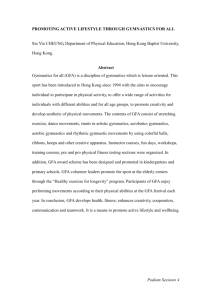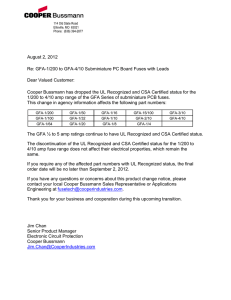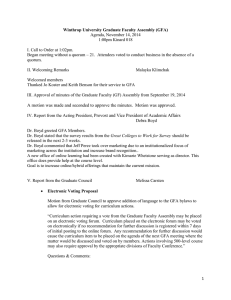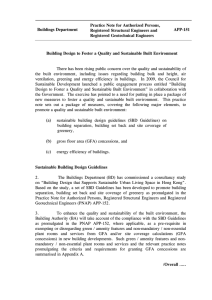PNAP APP-42 Amenity Features
advertisement
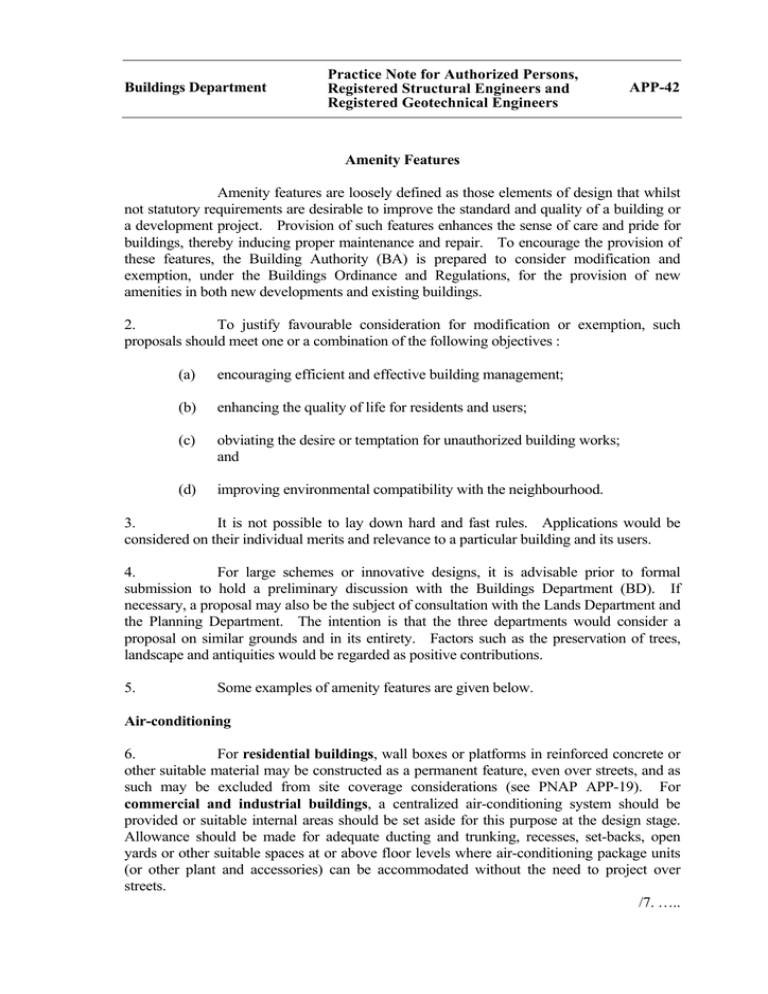
Buildings Department Practice Note for Authorized Persons, Registered Structural Engineers and Registered Geotechnical Engineers APP-42 Amenity Features Amenity features are loosely defined as those elements of design that whilst not statutory requirements are desirable to improve the standard and quality of a building or a development project. Provision of such features enhances the sense of care and pride for buildings, thereby inducing proper maintenance and repair. To encourage the provision of these features, the Building Authority (BA) is prepared to consider modification and exemption, under the Buildings Ordinance and Regulations, for the provision of new amenities in both new developments and existing buildings. 2. To justify favourable consideration for modification or exemption, such proposals should meet one or a combination of the following objectives : (a) encouraging efficient and effective building management; (b) enhancing the quality of life for residents and users; (c) obviating the desire or temptation for unauthorized building works; and (d) improving environmental compatibility with the neighbourhood. 3. It is not possible to lay down hard and fast rules. Applications would be considered on their individual merits and relevance to a particular building and its users. 4. For large schemes or innovative designs, it is advisable prior to formal submission to hold a preliminary discussion with the Buildings Department (BD). If necessary, a proposal may also be the subject of consultation with the Lands Department and the Planning Department. The intention is that the three departments would consider a proposal on similar grounds and in its entirety. Factors such as the preservation of trees, landscape and antiquities would be regarded as positive contributions. 5. Some examples of amenity features are given below. Air-conditioning 6. For residential buildings, wall boxes or platforms in reinforced concrete or other suitable material may be constructed as a permanent feature, even over streets, and as such may be excluded from site coverage considerations (see PNAP APP-19). For commercial and industrial buildings, a centralized air-conditioning system should be provided or suitable internal areas should be set aside for this purpose at the design stage. Allowance should be made for adequate ducting and trunking, recesses, set-backs, open yards or other suitable spaces at or above floor levels where air-conditioning package units (or other plant and accessories) can be accommodated without the need to project over streets. /7. ….. -2- 7. In accordance with Regulation 23(3)(b) of the Building (Planning) Regulations (B(P)R), any floor space genuinely intended for air-conditioning may be disregarded from gross floor area (GFA) calculations, subject to compliance with the pre-requisites and the overall cap on GFA concessions stipulated in PNAP APP-151. 8. The following provisions would be considered reasonable in the absence of the detailed design layout of the plants : (a) air-conditioning plant rooms not exceeding 1% of the total GFA of a building; and/or (b) air handling units, not exceeding 4% of the total GFA of each floor on which they are situated. If it is intended to exceed these percentages or where an air-conditioning room is provided in each domestic unit as described in paragraphs 11 and 12 below, full justification must be submitted. In such cases, the advice of the Director of Electrical and Mechanical Services may be sought during the plan processing stage. 9. If an unusually extensive system is proposed for exclusion from GFA calculations, then it should be shown in detail on the approved plans and be operational before an application for occupation permit or certification of completion of work under Form BA14 is made. 10. In all cases where buildings will be or are likely to be air-conditioned, careful consideration should be given to the location of the exhaust of the plant and the need to provide a disposal system for the condensation from the plant to prevent causing nuisance to adjoining occupants and the public. 11. In a residential building, for an air-conditioning plant room to be provided to serve an individual unit, such room should be located with access from outside that residential unit or from the common area of the building. If an air-conditioning plant room is proposed with access within an individual residential unit, the authorized person (AP) should justify why access to such room cannot be located outside the unit. In any event, the provision and size of such rooms need to be justified before consideration for disregarding from GFA calculations will be given. 12. In the event that such plant room is permitted to be provided with access within the individual unit, such plant room should meet the following criteria before it may be disregarded from GFA calculation :(a) the floor of the plant room should have a level difference of a minimum of 500mm with the floor of the main accommodation; /(b) ….. -3- (b) the plant room should have at least one side open, and provision of railing, open grille and louvre on the open side up to parapet level are acceptable. Enclosure above parapet level may be allowed where there is a need to separate the intake air and exhaust air. Enclosure for the purpose of compliance with Clause C11.1 of the Code of Practice for Fire Safety in Buildings 2011 may also be allowed on the open side; and (c) the open side should face into the open air. Security Gates 13. As long as they do not obstruct the means of escape from a building and have locks openable from the inside without keys, security gates may be installed prior to the issue of an occupation permit or acknowledgement of Form BA14, or may be indicated on floor plans in suitable positions for future installation. Suitable positions are considered to be : (a) entrances to individual units; (b) main staircase exits from buildings; and (c) in a composite building, between the domestic part and the non-domestic part. In this case, the gate would be across an exit route, preferably in a lobby, and should be designed to prevent the entry of non-residents into the domestic part of the building. Counters, Kiosks, Offices, Stores, Guard Rooms, and Lavatories for Watchmen and Management Staff 14. Such provision enhances the standards of control and maintenance of buildings. The BA will consider favourably on application for exemption from GFA calculations where such provision meets the following criteria: (a) it should not be excessive in size; (b) to prevent abuse, it should be located in an area designated as common parts in a Deed of Mutual Covenant (DMC) or falling within the definition of “common parts” under the Building Management Ordinance (BMO) (Cap. 344). In case there is no DMC formed at the time of application for approval, the developer or owner is required to submit an undertaking to BD to include the said areas as common parts in the DMC whenever one is formed; (c) the maximum GFA that may be allowed for exemption in a domestic building or domestic part of a composite building is 0.2% of the total domestic GFA or 5m2 for every 50 flats, whichever is smaller; and /(d) ….. -4- (d) the maximum GFA that may be allowed for exemption in a non-domestic building or non-domestic part of a composite building is 0.2% of the total non-domestic GFA or 120m2, whichever is smaller. 15. The granting of GFA concessions set out in paragraph 14 above is subject to compliance with the pre-requisites and the overall cap on GFA concessions stipulated in PNAP APP-151. Owners’ Corporation Office 16. Formation of Owners’ Corporation would enhance better building management. The BA will consider favourably on application for exemption of Owners’ Corporation Office in residential development from GFA calculations, with due reference to the required size under Lease if applicable, or justifications provided by the AP. 17. The granting of GFA concessions set out in paragraph 16 above is subject to compliance with the pre-requisites and the overall cap on GFA concessions stipulated in PNAP APP-151. Projections 18. These are generally covered in PNAP APP-19 and canopies are specifically dealt with in PNAP APP-68. 19. For individual domestic units, clothes-drying racks, anti-burglar bars and small window hoods designed to provide protection from the elements and falling objects would not have any site coverage or plot ratio implications. Horizontal Screens and Trellis 20. In open areas frequently used by occupants at ground floors or podium floors; or roof gardens/play areas at podium floor around the perimeter of a domestic tower, horizontal screens may be permitted to provide protection against inclement weather and falling objects subject to the following conditions: (a) the horizontal screens will not materially affect the lighting and ventilation of the areas or nearby buildings; (b) the areas are designated as common parts in the DMC or falling within the definition of “common parts” under the BMO, and (c) the areas do not form part of any commercial premises. 21. In assessing the acceptability of the width of the horizontal screens, the BA will take into consideration the population using the facility, the size of the development and the design of the screens. In any case, the width of such screens allowed to be exempted from GFA calculation should not exceed 2 m. /22. ….. -5- 22. The erection of trellis for growing of plants at garden area and on roof, including main roof and set-back roof, may be permitted and the area of trellis may be exempted from GFA calculation subject to the following conditions: (a) for roofs and gardens designated for private use, the maximum total area of the trellis is not more than 5% of the roof/garden area where it is situated or 20m2, whichever is the less; (b) for roofs and gardens designated as common parts in the DMC or falling within the definition of “common parts” under the BMO, the maximum total area of the trellis is not more than 5% of the roof area and not more than 10% of the garden area where such roof/garden is situated. However, the maximum size of each trellis should not exceed 20m2; (c) the trellis should be an open-sided structure with a height of not more than the storey height of the floor where the trellis is situated. For trellis situated on the roof, the height of the trellis should not be more than the storey height of the floor below. The horizontal supports or intermediate bars should not be nearer than 200mm from one another; (d) the trellis should not obstruct any required prescribed windows/open air for offices, rooms for habitation, kitchen, lavatory, bathroom, etc. of any building. For the avoidance of doubt, no trellis should be located on a refuge roof. The commentary to Clause B18.3 of the Code of Practice for Fire Safety in Buildings 2011 refers; and (e) compliance with the requirements from other departments including the Lands Department and Planning Department. 23. The granting of GFA concessions set out in paragraphs 20 and 21 above is subject to compliance with the pre-requisites and the overall cap1 on GFA concessions stipulated in PNAP APP-151. The erection of trellis for growing of plants set out in paragraph 22 above is not subject to the overall cap on GFA concession stipulated under PNAP APP-151. Prestige Entrances 24. These are generally covered in PNAP APP-2. The BA aims to adopt a liberal attitude towards the provision of such features for non-domestic developments. However, care must be taken in the design to ensure that future occupants would maintain the integrity of protected lobbies and corridors related to the means of escape and fireman's lifts. /25. ….. 1 The BA is prepared to consider excluding the GFA of horizontal screen set out in paragraphs 20 and 21 from the overall cap on GFA concession stipulated under PNAP APP-151, if the whole area of the top of the horizontal screen is provided with greenery to the satisfaction of the BA. The area of greenery provided at the horizontal screen in such case, however, should not be counted as part of the site coverage of greenery required under PNAP APP-152 if so applicable. -6- 25. The granting of GFA concessions set out in paragraph 24 above is subject to compliance with the pre-requisites and the overall cap on GFA concessions stipulated in PNAP APP-151. Communal Podium Garden, Covered Landscaped and Play Areas 26. The provision of communal podium gardens, covered landscaped and play areas is encouraged. Where these amenities occur under and within the perimeter of a domestic tower, a modification of Regulation 23(3)(a) of the B(P)R would be granted, provided the area is open in design and not encumbered with structural elements, and the total area exempted is within 5% of total domestic GFA. 27. The granting of GFA concessions set out in paragraph 26 above is subject to compliance with the pre-requisites stipulated in PNAP APP-151. Recreational Facilities 28. Certain other recreational facilities such as squash courts, gymnasiums, indoor swimming pools, sauna facilities, function rooms (for either active or passive recreational activities) are often clearly identifiable with a particular development and aim to benefit the residents and occupiers generally. These can be considered for exclusion from GFA calculations by modification of Regulation 23(3)(a) of the B(P)R on a case-by-case basis, subject to the limitation as stipulated in PNAP APP-104. 29. The granting of GFA concessions set out in paragraph 28 above is subject to compliance with the pre-requisites and the overall cap on GFA concessions stipulated in PNAP APP-151. Satellite Dishes/Satellite Master Antenna for Television 30. Satellite dishes and satellite master antenna for television (SMATV) are becoming quite common nowadays being installed in response to public demand. It would be appropriate therefore to make provision at the design stage of a building to accommodate such a feature. 31. The support for the installation of satellite dishes could be provided by way of cast-in-situ mounting blocks and/or built-in-fixing bolts together with an appropriate increase of the design load of the structural elements to accommodate the weight of the dish. 32. For multi-storey buildings, it is common to have one single system SMATV serving the whole building. A SMATV system typically consists of one or more satellite receiving dish antennas and other associated equipment installed in a room or cabinet at the rooftop of a building. /33. ….. -7- 33. Where the SMATV equipment is installed in the form of a cabinet of a size not exceeding 0.6m(W) x 0.6m(D) x 2.2m(H) and does not involve any building works, such an equipment cabinet is regarded as a plant which is not subject to the control of the BO. A room of a size not exceeding 1.2m(W) x 1.2m(D) for housing SMATV system equipment and located in an area designated as common parts in the DMC or falling within the definition of “common parts” under the BMO may be exempted from GFA calculation in accordance with PNAP APP-2. Radio Base Stations 34. Radio base stations may be installed by public telecommunication services operators, including mobile services operators, on the roof or in various parts of a building for delivery of their services. A radio base station may comprise an equipment cabinet which is used for housing power supply and transmission equipment and/or antennas which are fixed to the roof parapets or attached to supporting frames projecting from the external walls of a building. 35. A radio base station in the form of an equipment cabinet solely for the purpose of housing transmission equipment and of size not exceeding 1.5m (W) x 1m (D) x 2.3m (H) is regarded as a plant which is not subject to the control of the BO. However, the construction of any supporting structure for such cabinet is building works subject to the control of the BO and is designated as an item of Class I Minor Works under the Building (Minor Works) Regulation. 36. The erection of equipment cabinet exceeding the size stipulated in paragraph 35 above or room / shelter for installation of a radio base station on the roof is building works subject to the control of the BO. The floor space of such equipment cabinet, room or shelter is accountable for GFA under Regulation 23(3)(a) of the B(P)R. Such equipment cabinet, room or shelter, whether forming part of a new building or being newly added to an existing building, is regarded as a new building requiring the issuance of an occupation permit under section 21 of the BO before its occupation. 37. Useful information can be found in the “Guidance Note for Submission of Applications by Public Telecommunications Operators for the Installation of Radio Base Stations for Public Telecommunications Services in Buildings and on Rooftops” issued by the Communications Authority and PNAP APP-147 on Minor Works Control System. Outdoor Prefabricated Structures 38. An outdoor prefabricated structure, other than a radio base station which does not exceed 3m3 in volume and 2m in height, is not regarded as a building. Nevertheless, the erection of such structure should not affect the structural safety and drainage system of its parent building. Any outdoor prefabricated structure exceeding the above size limit is regarded as a building which will be subject to the control of the BO including, inter alia, the requirement for prior approval of plans and consent to the commencement of works and the requirement for an occupation permit before they can be occupied. /Concluding ….. -8- Concluding Observations 39. The BA is open to suggestions for consideration as amenities in the context of this practice note. Application of Previous Versions of this Practice Note 40. The "February 2003" and "January 2011" versions of this practice note as appropriate are applicable to building plans submitted/approved under the scenarios as stated in paragraphs 33 to 35 of the "January 2011" version of the practice note. ( AU Choi-kai ) Building Authority Ref. : BD GP/BORD/48 BD GP/BREG/P/9 (IV) BD GP/BORD/38 This PNAP is previously known as PNAP 116 First issue October 1985 Last revision January 2011 This revision January 2013 (AD/NB1) (General revision)

